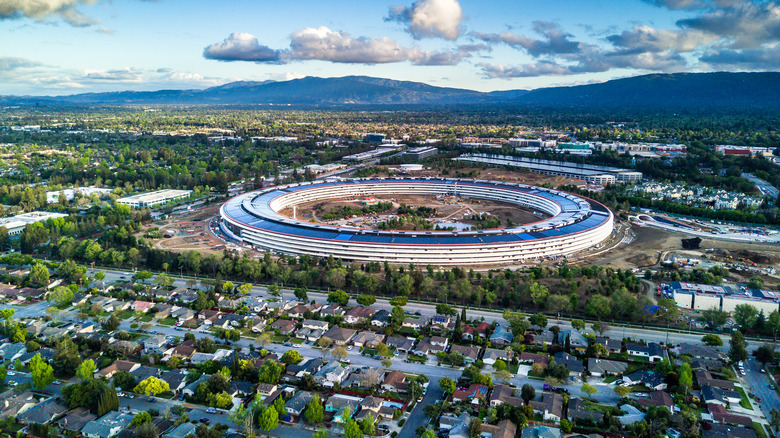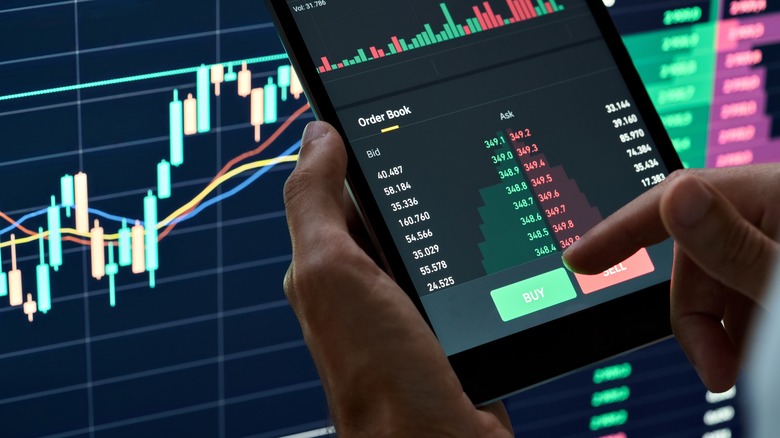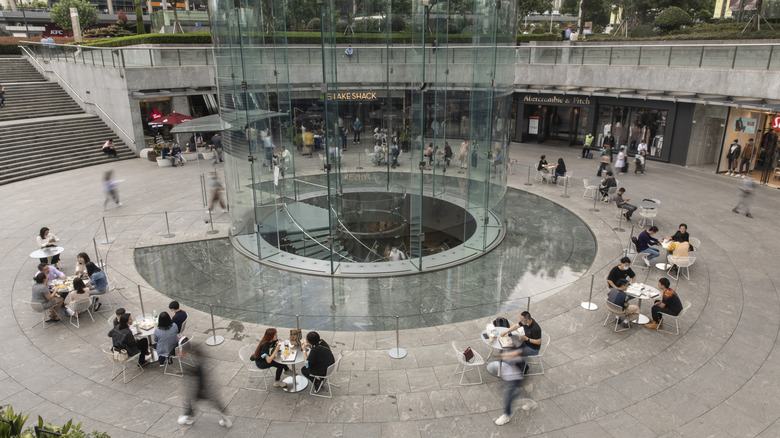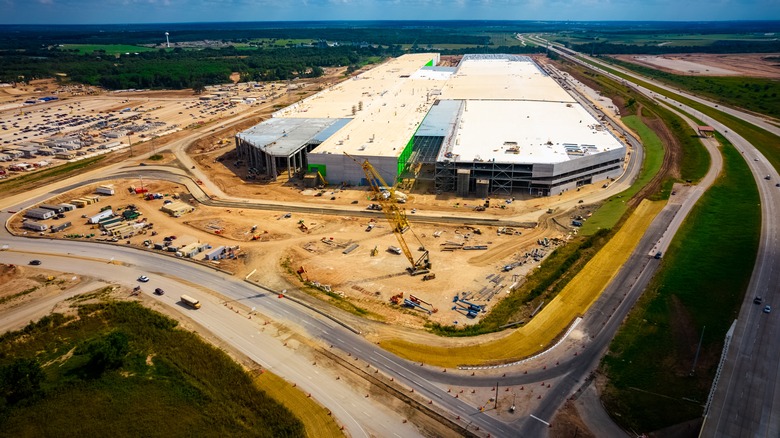Inside The End Of Silicon Valley's Dynasty
It's a vital part of the US economy, and has been home to the world's foremost innovators and investors for decades — but Silicon Valley's dominance over the world of technology might be coming to a close. Over the past few years, the world has seen civil unrest, a global pandemic, an economic boom, and the looming specter of recession or even depression. All of those factors ultimately drive change, and change doesn't always work out for everyone.
The area and its dominance over the tech industry is facing multiple threats. Silicon Valley has survived some of the challenges it is facing before, but others aren't as traditional. Ironically, some of the technologies the area helped make popular, like the internet and personal computers, may be some of the tools used to bring about its downfall. Although there are certainly financial threats, an inability to adapt with change may cause the end of one of the great drivers of innovation and change in the modern world. Here we'll take a look at how time could be running out for Silicon Valley.
What is Silicon Valley
Silicon Valley has no set boundaries but most definitions see it as taking up a large part of Northern California. Joint Venture Silicon Valley and the Institute for Regional Studies (opens as a PDF) say Silicon Valley spans four counties, Santa Clara, San Mateo, Alameda, and Santa Cruz. Those counties contain several major cities, including San Jose and Menlo Park, and a combined population of over three million people.
It is also the heart of the American technology industry. The Silicon Valley tech industry employs 583,300 people, with half of those working for one of the region's 25 largest technology companies, the PDF notes. The concentration of workers increases with the size of the company, with the 15 largest companies employing 35% of tech workers, and 20% of the workforce having positions at just five companies based in the region. Google employs 7% of Silicon Valley tech workers, Apple employs 6%, Meta employs 3%, Amazon and Cisco each employ 2%. The market cap of Silicon Valley companies reached $14 trillion in December 2021, and over $95 billion in venture capital was invested that same year. These statistics are just the tip of the iceberg. A staggering 52% of Californian patents and 14% of US patents are filed in Silicon Valley each year. It's an area of the country where innovators go to spitball ideas and investors line up to throw money at them.
The technological hotbed is also a key part of California's economy
The Joint Venture Silicon Valley and the Institute for Regional Studies report also sheds light on what a massive portion of the Californian economy is dependent on Silicon Valley. Despite taking up just over 1% of the land area and containing less than 8% of the state's population Silicon Valley accounts for close to 20% of California's gross domestic product. Any decline in its prosperity would have a tremendous impact on the state as a whole. The area's residents also possess close to $1.17 trillion in assets and real estate.
Despite its size, the revenues generated in Silicon Valley are so great that it would be the second richest country on Earth in terms of GDP per capita if it gained independence, with an average salary of $128,308 per person. If judged purely on raw economic output, the $275 billion Silicon Valley produces each year would still dwarf the output of several developed countries, including Finland (via Fox News).
Tech Stocks aren't doing well
Unfortunately, nothing lasts forever. After peaking in late 2021, Silicon Valley as a whole has taken a beating in the stock market. Market Watch report that the tech-heavy NASDAQ has declined more than 27.5% since the start of the year, putting it well into bear market territory. In mid-May, Morningstar reported that their US Technology Index is down 28% with major tech firms like Microsoft, and Alphabet (who own Google) down by more than 20%, NVIDIA and Meta down by more than 40%, and streaming company Netflix losing just shy of three-quarters of its value since the year began.
Time Magazine puts the decline down to several factors including the rising interest rates and waning faith in the US economy. The publication cites a report from Deutsche Bank that claims it is "highly likely that the Fed will have to step on the brakes even more firmly, and a deep recession will be needed to bring inflation to heel." There is also a suggestion that tech stocks could be the proverbial canary down the mineshaft and the dip they are experiencing is merely a preview of what is about to happen to the wider market.
A financial crash could hit Silicon Valley Hard
Despite the battering tech company share prices have already taken, some experts say this is merely the beginning. CNN Business says that experts are "starting to predict a downturn later this year or in early 2023," and cited City National Rochdale's chief investment officer Tom Galvin's advice to "avoid speculative tech stocks" because of "worries about excessive valuations and a potential economic downturn." Galvin claimed in mid-May that the volatile market period we are currently experiencing is not over.
While there are obvious dangers during a market decline, such as a lack of new investment and even liquidation, a recession could impact Silicon Valley particularly hard. The tumbling share price could have an enormous impact on the workers, innovators, and talent that ultimately make Silicon Valley what it is. Companies have been using stock handouts and options to lure in vital workers and keep them happy without hurting their bottom line too much. Investor, hedge fund manager, and Third Point CEO, Dan Loeb wrote to his investors in May claiming that "it is difficult to call a bottom in the high-growth, high-valuation end of the tech sector, especially given that many of these companies relied on stock-based compensation and controversial accounting and reporting techniques." Loeb goes on to predict companies that attracted talent in this way may begin to experience "retention difficulties" leading to "increased dilution for future stock grants or increased cash wages."
This has happened before
The '90s tech boom created an environment in which a lot of tech companies were overvalued and not really making any money. Inevitably, it all eventually came crashing down. The NASDAQ peaked in March 2000, just one month later it had lost over 30% of its value with some tech companies' losing 80% of their market capitalization in that time. By November, publicly traded companies had lost an estimated 1.7 trillion. By 2003, around half of the online companies that had launched in the late '90s had dissolved. The ones that survived would take years to recover from the effects of the dot com bubble bursting.
Investors, most of whom were regular people hopping on the dot com hype train, lost trillions. A recession briefly took hold, and thousands of tech workers suddenly found themselves looking for new jobs. Around 200,000 tech jobs disappeared between 2001 and 2004 (via TED). With tech stocks tumbling since January, and many experts claiming we are in a bubble, there is every danger of a similar event to the Dot Com bubble happening again. Some of the tech companies that survived eventually recovered and thrived. Notable survivors include Microsoft, Amazon, and eBay. However, while Silicon Valley has powered through two major financial crises, other factors have emerged in the last couple of years which may mean the area is on borrowed time.
The battle over remote work is a game-changer
The coronavirus pandemic changed life around the world and most of the impacts, like nationwide lockdowns, may not be remembered fondly. Some people did take to certain changes brought about by the pandemic, and one of those was remote work. High-speed internet, wide-ranging adoption of personal computers, meeting software like Zoom, and remote desktop software, have all made remote work possible — and the pandemic provided proof of remote work's viability. CNN Business reports that 60% of remote workers would like to stay working remotely most if not all of the time. The problem is that employers and politicians are calling for staff to return to the office — with some business leaders saying "they don't believe in hybrid work, that it has no place in their culture," and some politicians citing the financial impact remote work is having on city centers.
Something has to give, and at Apple something already has. Ian Goodfellow, the tech giant's director of machine learning, quit after Apple put plans in place to get its workers back into its offices. Goodfellow isn't alone, 76% of Apple's staff said they were unhappy with the company's plans to bring them back to the office, and 55% claim to have considered following Goodfellow and resigning over the issue. The problem isn't just exclusive to Apple. Across the US, 50% of workers claim they would rather resign than be forced back to the office (via BBC).
Why remote work could spell the end of Silicon Valley
The Silicon Valley Index highlights how that area of northern California is one of the most expensive areas of the country. For workers, rent, housing, and living expenses are through the roof. The same applies to business, with the land cost of Apple's Silicon Valley headquarters totaling $160 million, and the final cost of the campus amounting to $5 billion (via Bloomberg).
Remote work ultimately gives workers the option to relocate somewhere their money will go further. Work/life balance also improves, especially as commuting time is effectively eliminated, which gives staff more time to themselves. Although some businesses, including Apple, may be resisting the shift, they can also draw benefits from remote work. A society more accepting of remote work allows businesses to downsize their offices and reduce overheads while providing a wider range of talent to access. Claims have been made that workers are more productive when operating remotely, and staff retention improves when remote work is offered (via SpaceIQ).
The remote-work revolution has given tech companies outside of Silicon Valley access to a far larger talent pool, allowing them to grow and compete like never before. These companies hired employees on the basis of being remote, so going back to the office was never on the table (via the New York Times). If Silicon Valley loses workers who demand the option of working remotely, more flexible companies could find a lot of new talent available.
Some tech entrepreneurs are opting out of the Silicon Valley system
Silicon Valley may no longer be the place to go when you want to launch a tech start-up. Instead, "digital nomads" are launching their businesses on the road, and taking their company with them wherever they want to go. Some business owners like the cofounder of SparkRental, Brian Davis, have far lower living expenses on the road than they would in a major American city. As a result, Davis says up to 60% of his and his wife's income is invested or pumped back into their business.
Davis isn't alone, many tech entrepreneurs aren't bothering with the traditional quest for venture capital funding and are instead choosing to "bootstrap their business." This may work out better for some businesses too, as the venture capital model demands rapid growth — which might have caused companies to go under that would otherwise have survived with a more considered approach (via The New York Times). The ability to drum up large amounts of venture capital is one of Silicon Valley's lures, with over 75% of California's venture capital invested in the area. If bootstrapping becomes the norm, many new business owners may not feel the need to make the move to Northern California.
A mass exodus from California is also a threat
Tesla was one of Silicon Valley's higher-value companies — then it moved its HQ to Texas. Following the move in December 2021, the company's new HQ is listed as a "gigafactory" near Austin. Although they maintain a presence in California, up to 50% of the company's Palo Alto workforce is expected to follow Tesla to Texas. One of the reasons Tesla owner Elon Musk cited for the shift was the high cost of living in California, which he claims made it difficult for workers to afford homes. Musk first hinted at the move after a disagreement with Alameda County health officials in 2020 (via US News). The world's richest man is also expected to save around $2.5 billion in capital gains tax because of the move (via Business Insider).
Musk's electric car company wasn't the only Silicon Valley giant to make the move and is unlikely to be the last. Bloomberg reports that Hewlett Packard made the shift after citing the difference in real estate expenses between the Golden and Lone Star states, with Oracle Corp also making the move. If other major companies also make the decision to leave Silicon Valley, it could spell disaster for the area — especially given how income and employee numbers are split. If just Google, Apple, Meta, Amazon, and Cisco left Silicon Valley would lose 20% of its employees and billions of dollars in GDP. High taxes and living costs may soon drive companies and workers away from Silicon Valley, and towards cheaper states with Texas a regular target. If it declines to nothing, there may never be another Silicon Valley, but if a second tech hub springs up it will likely be in the Lone Star State.









